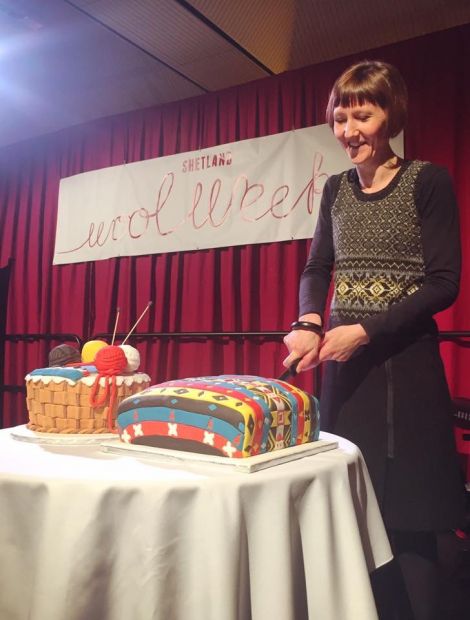Features / Inspired celebration of Shetland’s wool tradition
THE QUEUE for Sunday night’s Shetland Wool Week opening ceremony started at the door of the Bowls Hall, snaked past reception and out through the main entrance, writes Genevieve White.
Luckily, wool week queues are far more pleasant to wait in than most. For one thing, at the first whiff of boredom or impatience, out comes the knitting. Secondly, time just flies when everyone is busy admiring each other’s toories and gansies.
Australian visitor and knitting teacher Julia Billings was experiencing her first ever Shetland Wool Week along with a group of four friends. She said: “I’m looking forward to getting a vision of the knitting tradition and the way this works in Shetland today.
“I’m going to visit Uradale farm on Monday and I think it will be really interesting to learn about the crofting side of things.”
Emily Williams from Inverness admitted to having gone “a bit mental” when selecting her workshops for the week.
“I’m going to so many different things. I’m really excited about the coiled basketry workshop. My mum’s a basket-maker, so I’ll be able to go back and tell her what I’ve learned here. I think that Shetland Wool Week offers such a great variety of events.”
The Shetland Wool Week opening ceremony kicked off with music from Royal Military Tattoo performers, Hjaltibonhoga Fiddlers. The fiddlers were resplendent in knitwear designed by local textile artist Niela Kalra: some wore pieces inspired by the Mirrie Dancers, while others were clad in what has been described as the ‘Shetland sari’.
The evening was genially compered by Shetland fiddler Claire White, who was wearing a delicate stole draped around her shoulders. “It’s my own christening stole, although this is the first time I’ve worn it in all these years.”
Become a member of Shetland News
Later, White said that her mother had knitted the stole before she had even been conceived, following a pattern called “Spider’s web stole”.
The evening continued with speeches from wool week organisers. The “two powerhouses” of wool week, Misha Hay and Selena May Miller, talked about the increasing scope of the festival: what started as a week-long festival has now become a “year-long promotion of Shetland wool and knitting”.
Knitting classes for children have been launched this year and so has the new wool week annual.
Wool week patron Donna Smith commented on the “surreal” sensation of seeing such a large number of her own Baa-ble hats in the audience.
Smith went on to speak about the important of wool week to Shetland culture: “It’s up to us to make sure that knitting knowledge does not get lost. Wool week inspires people and brings like-minded folk together to share ideas and knowledge.”
Smith went on to say that she had been “heartened” by some of the responses she had had to her Baa-ble hat design: “I’ve heard people who have never knitted before saying they enjoyed knitting the hat. Some of these knitters have been teenagers, and that’s really good to hear.”
Wool broker Oliver Henry was “ordered” to start wool week in 2010: his speech recalled how he was given a month to organise the first event. Henry proceeded to reflect on the central part which wool has played in his life from his Burra childhood onwards.
“Fishing was a hard, hard life,” he said. “When the boat couldn’t go out, there was no income. Wool was a lifeline which could keep families going. I remember as a bairn, there were many times I would fall asleep and wake up to the noise of the knitting machine.”
After the speeches, the cutting of an incredible Fair Isle cake marked the official opening of the event and signalled the continuation of the evening’s entertainment.
Next up were two question and answer sessions: one about Shetland wool and crofting and one on Shetland knitting and spinning.
The wool and crofting Q&A saw Oliver Henry, shop owner Garry Jamieson and local farmer Ronnie Eunson field a variety of questions on sheep husbandry, sales of Shetland organic wool and the benefits of teaching children knitting.
To this last question, Eunson replied: “Knitting is a skill so easily taught and it gives children the ability to express themselves in a different way. The fact that knitting has been pulled from our schools shows the short-sightedness of our local council.”
The evening’s final event was as inspirational as it was entertaining. It came in the form of a debut performance from “the knitting pundits”, also known as Knitsonik.
Knitsonik’s work combines hand-knitting with digital soundwaves – a sure sign that there is plenty of scope for traditional knitting to adapt and evolve to suit changing times.
Become a member of Shetland News
Shetland News is asking its many readers to consider paying for membership to get additional features and services: -
- Remove non-local ads;
- Bookmark posts to read later;
- Exclusive curated weekly newsletter;
- Hide membership messages;
- Comments open for discussion.
If you appreciate what we do and feel strongly about impartial local journalism, then please become a member of Shetland News by either making a single payment, or setting up a monthly, quarterly or yearly subscription.




























































